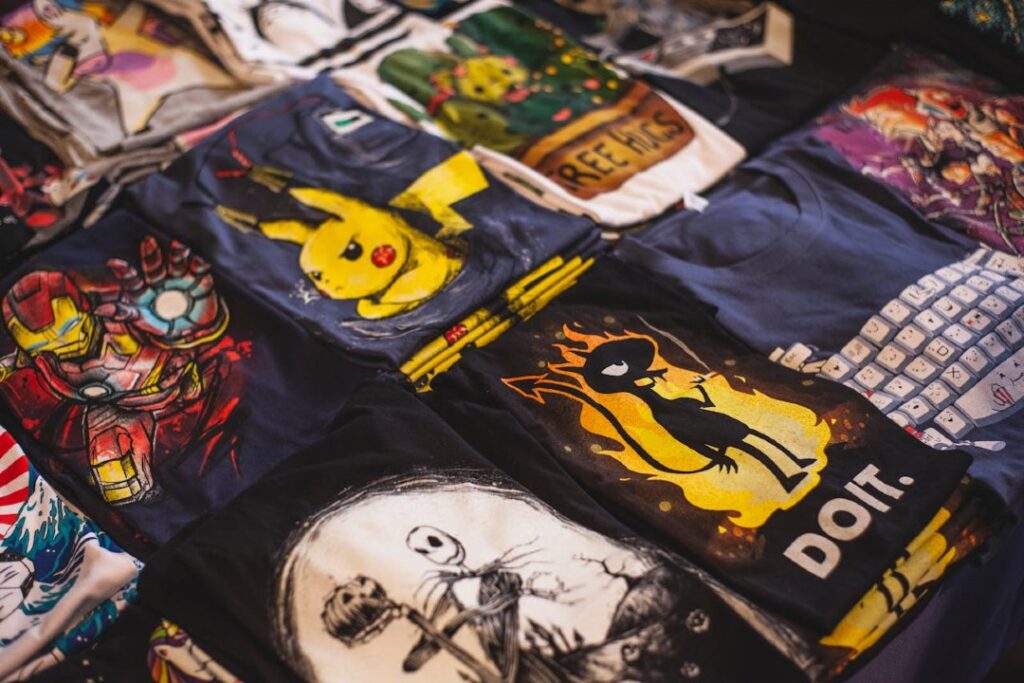Succeeding as a Print on Demand (POD) shop on Etsy requires a strategic approach that combines creativity, market research, and operational efficiency. Below is a detailed guide to help you thrive in this competitive marketplace, tailored for 2025 based on current trends and best practices.
1. Understand the Print on Demand Model and Etsy’s Ecosystem
What is Print on Demand?
POD allows you to sell custom-designed products (e.g., t-shirts, mugs, posters, phone cases) without holding inventory. When a customer places an order, the POD provider (e.g., Printful, Printify, Gelato) produces and ships the item directly to the buyer.
Why Etsy?
Etsy is a marketplace focused on handmade, vintage, and unique items, with a massive audience (over 90 million active buyers in 2023). It’s ideal for niche, creative, and personalized products, making it perfect for POD.
Key Considerations:
- Etsy charges listing fees ($0.20 per listing), transaction fees (6.5% of the sale price), and payment processing fees (varies by region). Factor these into your pricing.
- Etsy prioritizes shops with high-quality listings, good customer service, and consistent sales.
2. Conduct Thorough Market Research
To stand out on Etsy, you need to identify profitable niches and understand customer demand.
Find a Niche:
Broad categories like “t-shirts” are oversaturated. Niching down (e.g., “funny cat-themed yoga shirts” or “minimalist travel posters”) reduces competition and attracts dedicated buyers.
- Tools to use:
- EverBee or Sale Samurai: Analyze top-performing Etsy listings to identify trending niches, keywords, and pricing.
- Google Trends: Check seasonal trends for products (e.g., holiday-themed items spike in Q4).
- Pinterest: Look for design inspiration and trending aesthetics.
- Tips:
- Focus on evergreen niches (e.g., pet lovers, fitness, teachers) or seasonal trends (e.g., Halloween, Christmas).
- Research underserved niches with high demand but low competition (e.g., specific hobbies, professions, or fandoms).
Analyze Competitors:
- Search Etsy for your niche (e.g., “funny dog t-shirts”).
- Note top sellers’ designs, pricing, listing quality, and customer reviews.
- Identify gaps (e.g., missing size options, outdated designs) you can fill.
Understand Your Audience:
- Create buyer personas (e.g., “25–40-year-old women who love yoga and cats”).
- Tailor designs to their preferences, such as minimalist, bold, or humorous styles.
3. Choose the Right Print on Demand Provider
Your POD provider is critical to your shop’s success, as they handle production, quality, and shipping.
Popular POD Providers for Etsy (2025):
Printful: High-quality products, fast shipping, and seamless Etsy integration. Offers a wide range of products (apparel, home decor, accessories).
Printify: Affordable pricing with a large network of print providers worldwide. Great for testing multiple products.
Gelato: Focuses on sustainability and local production (reduces shipping times). Ideal for eco-conscious buyers.
TeePublic or Redbubble: Good for beginners but less control over branding and margins.
Factors to Consider:
Product Quality: Request samples to ensure the print and material meet your standards.
Shipping Times and Costs: Choose providers with fulfillment centers close to your target market (e.g., US, EU). Fast shipping (3–7 days) is crucial for customer satisfaction.
Integration with Etsy: Ensure the provider syncs seamlessly with Etsy for automated order fulfillment.
Product Range: Offer diverse products (e.g., t-shirts, hoodies, mugs, stickers) to increase sales opportunities.
Pricing: Compare base costs to ensure healthy profit margins (aim for 30–50% after Etsy fees).
Action Step: Sign up for 2–3 providers, test their samples, and choose one or two that align with your needs.
4. Create High-Quality Designs
Your designs are the heart of your POD shop. They need to be unique, appealing, and professional.
Design Tips:
Originality: Avoid copying designs to prevent copyright issues. Use tools like Canva, Adobe Photoshop, or Affinity Designer to create unique graphics.
Trends: Stay updated on design trends (e.g., retro, typography, or pastel aesthetics in 2025). Follow design blogs or X posts for inspiration.
Simplicity: Clean, bold designs often perform better than overly complex ones.
Text-Based Designs: Funny, inspirational, or niche-specific quotes (e.g., “Coffee & Cats = Life”) are popular on apparel.
Customization: Offer personalization options (e.g., “Custom Pet Name Mug”) to increase perceived value.
Tools for Design:
Canva: User-friendly for beginners, with templates for POD products.
Adobe Express: Free alternative with design tools.
Procreate: Great for hand-drawn or artistic designs.
Kittl: Ideal for typography-heavy designs.
Hire Designers: If you’re not a designer, hire freelancers on Fiverr or Upwork for custom work.
File Requirements:
Use high-resolution files (300 DPI, PNG with transparent background).
Follow your POD provider’s size and format guidelines (e.g., 4500×5400 pixels for apparel).
Mockups:
Use professional mockups from your POD provider or tools like Placeit to showcase your designs realistically in listings.
5. Set Up Your Etsy Shop
A well-optimized shop builds trust and drives conversions.
Shop Branding:
Shop Name: Choose a memorable, niche-relevant name (e.g., “PetLoversPrints”).
Logo and Banner: Create a cohesive, professional look using tools like Canva.
Shop Policies: Clearly outline shipping, returns, and processing times.
Product Listings:
Title: Use 140 characters to include descriptive keywords (e.g., “Funny Cat T-Shirt, Cute Pet Graphic Tee, Women’s Casual Shirt”).
Photos:
- Use 5–10 high-quality images, including mockups, close-ups, and lifestyle shots.
- Ensure bright, clear visuals with consistent branding.
- Add infographics (e.g., size charts, personalization instructions).
Description:
- Highlight product features (e.g., “100% cotton, vibrant prints, unisex fit”).
- Include emotional appeal (e.g., “Perfect gift for dog moms!”).
- Add keywords naturally for SEO.
Tags: Use all 13 tags with specific, relevant keywords (e.g., “dog lover gift,” “funny t-shirt”).
Pricing:
- Calculate costs: POD base price + Etsy fees + shipping.
- Aim for a 30–50% profit margin (e.g., $10 base cost + $10 margin = $20 sale price).
- Research competitors to stay competitive (e.g., t-shirts typically sell for $15–$30).
Shipping:
- Offer free shipping (build cost into product price) to attract buyers.
- Clearly state processing (1–3 days) and shipping times (3–10 days, depending on provider).
- Use Etsy’s calculated shipping feature for accuracy.
Action Step: Create 10–20 listings initially, focusing on a cohesive niche and high-quality visuals.
6. Optimize for Etsy SEO
Etsy’s search algorithm prioritizes listings that match buyer intent and perform well.
Keyword Research:
- Use tools like eRank or Marmalead to find high-traffic, low-competition keywords.
- Include keywords in titles, tags, descriptions, and attributes (e.g., size, color).
- Focus on long-tail keywords (e.g., “personalized teacher tote bag” vs. “tote bag”).
Listing Performance:
- Listings with sales, reviews, and high click-through rates rank better.
- Refresh listings every 3–4 months to keep them active (Etsy favors fresh content).
- Use Etsy Ads (start with $1–$5/day) to boost visibility for new shops.
Action Step: Spend 1–2 hours researching keywords and optimizing your first batch of listings.
7. Market Your Shop
Driving traffic to your Etsy shop is essential, especially in the early stages.
On-Etsy Marketing:
Etsy Ads: Start with a small budget to promote best-performing listings.
Sales and Discounts: Offer 10–20% off to attract first-time buyers.
Etsy Share & Save: Encourage buyers to share your listings on social media for a discount.
Off-Etsy Marketing:
Social Media:
- Use Instagram and Pinterest to showcase mockups and lifestyle images.
- Post Reels or Stories with trending audio to increase reach.
- Create a content calendar (e.g., 3 posts/week showcasing products, behind-the-scenes, or customer reviews).
TikTok: Share short videos of your design process or product reveals to tap into viral trends.
Email Marketing: Use Mailchimp to collect emails and send newsletters with new products or discounts.
Influencer Marketing: Partner with micro-influencers in your niche to promote products.
Cross-Promotion:
- Include thank-you cards or QR codes in packages to encourage repeat purchases or social media follows.
- Offer bundle deals (e.g., “Buy 2 t-shirts, get a sticker free”).
Action Step: Set up Instagram and Pinterest accounts, post 3–5 times per week, and experiment with Etsy Ads.
8. Provide Excellent Customer Service
Customer satisfaction drives reviews, repeat purchases, and Etsy algorithm favorability.
Communication:
- Respond to messages within 24 hours.
- Use Etsy’s saved replies for common questions (e.g., sizing, shipping).
- Be polite and proactive in resolving issues.
Order Fulfillment:
- Ensure your POD provider delivers on time.
- Double-check personalization details to avoid errors.
- Include tracking information for all orders.
Returns and Refunds:
- Offer hassle-free returns (within Etsy’s 30-day policy) to build trust.
- Address defective or incorrect orders promptly by coordinating with your POD provider.
Encourage Reviews:
- Include a note in packages asking for reviews.
- Follow up with buyers via Etsy messages (e.g., “Hope you love your t-shirt! Please share your feedback.”).
Action Step: Create a customer service template for common inquiries and test your POD provider’s reliability with a sample order.
9. Scale Your Shop
Once your shop gains traction, focus on scaling to increase revenue.
Expand Product Offerings:
- Add complementary products (e.g., if t-shirts sell well, offer hoodies or mugs in the same niche).
- Test new niches based on customer feedback or trends.
Optimize Listings:
- Analyze Etsy analytics to identify top-performing listings.
- Update underperforming listings with new designs, keywords, or photos.
Increase Margins:
- Negotiate bulk discounts with your POD provider.
- Test premium products (e.g., organic cotton tees) for higher price points.
Outsource Tasks:
- Hire virtual assistants for customer service or listing creation.
- Outsource design work to scale production.
Diversify Sales Channels:
- Use your Etsy success to launch a standalone website (e.g., via Shopify with Printful integration).
- Sell on other marketplaces like Amazon or Redbubble to diversify income.
Action Step: Set a goal to add 5–10 new listings per month and track sales data weekly.
10. Stay Compliant and Manage Finances
Running a legal and profitable shop is critical for long-term success.
Legal Considerations:
- Copyright and Trademarks: Ensure designs are original or licensed. Avoid using trademarked phrases or logos (e.g., Disney, Harry Potter).
- Business Registration: Register your business (e.g., LLC) if required in your country.
- Taxes: Track income and expenses. Use tools like QuickBooks or Wave to manage finances. Consult a tax professional for Etsy-specific tax obligations.
Financial Management:
- Reinvest early profits into marketing or new designs.
- Keep a spreadsheet of costs (POD, Etsy fees, marketing) vs. revenue.
- Set aside 20–30% of earnings for taxes.
Action Step: Register for an Etsy seller account, set up a business bank account, and review Etsy’s seller policies.
11. Monitor Trends and Adapt
The POD market evolves quickly, so staying agile is key.
Track Trends:
- Follow X posts and hashtags (e.g., #EtsySeller, #PrintOnDemand) for real-time insights.
- Monitor seasonal events (e.g., back-to-school, holidays) and create timely designs.
- Use Google Trends or Etsy’s search bar to spot rising keywords.
Test and Iterate:
- Launch 5–10 new designs monthly and retire low-performers.
- A/B test listing photos, titles, and prices to optimize conversions.
Action Step: Dedicate 1 hour weekly to researching trends and updating your shop.
12. Common Pitfalls to Avoid
Saturated Niches: Avoid generic products (e.g., plain “Mom” mugs) without unique twists.
Poor Quality: Low-quality designs or products lead to bad reviews.
Neglecting SEO: Weak keywords reduce visibility.
Slow Shipping: Long delivery times frustrate customers.
Ignoring Reviews: Negative feedback can tank your shop’s ranking.
Resources and Tools
POD Providers: Printful, Printify, Gelato, TeePublic.
Design Tools: Canva, Adobe Express, Kittl, Procreate.
SEO Tools: eRank, Marmalead, EverBee.
Marketing Tools: Mailchimp, Placeit, Buffer (for social media scheduling).
Analytics: Etsy Seller Dashboard, Google Analytics (for off-Etsy traffic).
By combining niche research, high-quality designs, optimized listings, and strategic marketing, you can build a thriving POD shop on Etsy. Start small, test often, and scale with data-driven decisions.



